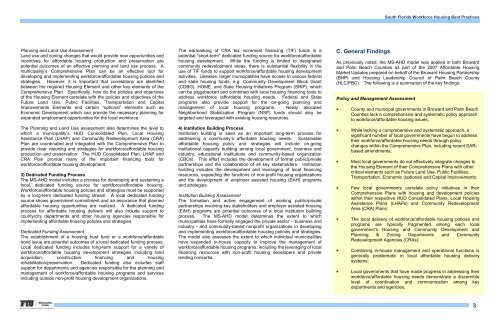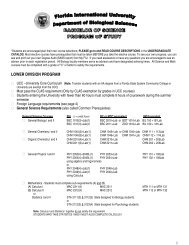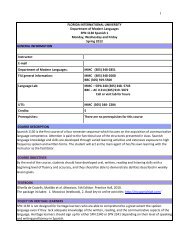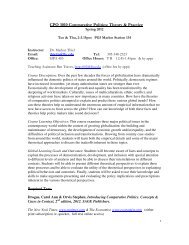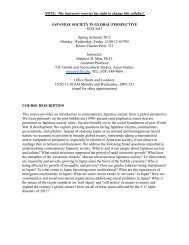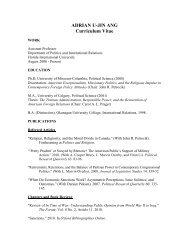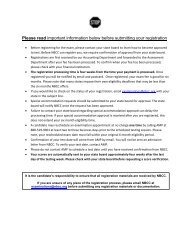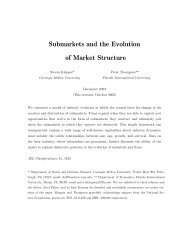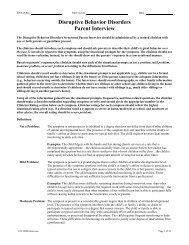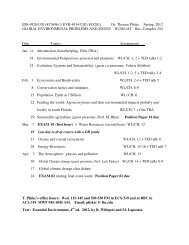South Florida Workforce Housing Best Practices
South Florida Workforce Housing Best Practices
South Florida Workforce Housing Best Practices
You also want an ePaper? Increase the reach of your titles
YUMPU automatically turns print PDFs into web optimized ePapers that Google loves.
Planning and Land Use Assessment<br />
Land use and zoning changes that would provide new opportunities and<br />
incentives for affordable housing production and preservation are<br />
potential outcomes of an effective planning and land use process. A<br />
municipality’s Comprehensive Plan can be an effective tool for<br />
developing and implementing workforce/affordable housing policies and<br />
strategies. However, it is important that correlations are identified<br />
between the required <strong>Housing</strong> Element and other key elements of the<br />
Comprehensive Plan. Specifically, how do the policies and objectives<br />
of the <strong>Housing</strong> Element correlate with the policies and objectives of the<br />
Future Land Use, Public Facilities, Transportation and Capital<br />
Improvements Elements and certain “optional” elements such as<br />
Economic Development which can provide the necessary planning for<br />
expanded employment opportunities for the local workforce.<br />
The Planning and Land Use assessment also determines the level to<br />
which a municipality’s HUD Consolidated Plan, Local <strong>Housing</strong><br />
Assistance Plan (LHAP) and Community Redevelopment Area (CRA)<br />
Plan are coordinated and integrated with the Comprehensive Plan to<br />
provide clear visioning and strategies for workforce/affordable housing<br />
production and preservation. The HUD Consolidated Plan, LHAP and<br />
CRA Plan provide many of the important financing tools for<br />
workforce/affordable housing development.<br />
3) Dedicated Funding Process<br />
The MS-AHD model includes a process for developing and sustaining a<br />
local, dedicated funding source for workforce/affordable housing.<br />
<strong>Workforce</strong>/affordable housing policies and strategies must be supported<br />
by a long-term dedicated funding stream. A local dedicated funding<br />
source shows government commitment and an assurance that planned<br />
affordable housing opportunities are realized. A dedicated funding<br />
process for affordable housing delivery will also include support to<br />
county/city departments and other housing agencies responsible for<br />
implementing affordable housing policies and strategies.<br />
Dedicated Funding Assessment<br />
The establishment of a housing trust fund or a workforce/affordable<br />
bond issue are potential outcomes of a local dedicated funding process.<br />
Local dedicated funding includes long-term support for a variety of<br />
workforce/affordable housing development strategies including land<br />
acquisition, construction financing and housing<br />
rehabilitation/preservation. Dedicated funding also includes staff<br />
support for departments and agencies responsible for the planning and<br />
management of workforce/affordable housing programs and services<br />
including outside non-profit housing development organizations.<br />
The earmarking of CRA tax increment financing (TIF) funds is a<br />
potential “short-term” dedicated funding source for workforce/affordable<br />
housing development. While the funding is limited to designated<br />
community redevelopment areas, there is substantial flexibility in the<br />
use of TIF funds to support workforce/affordable housing development<br />
activities. Likewise, larger municipalities have access to various federal<br />
and state housing funds, e.g. Community Development Block Grant<br />
(CDBG), HOME, and State <strong>Housing</strong> Initiatives Program (SHIP), which<br />
can be piggybacked and combined with local housing financing tools to<br />
address workforce /affordable housing needs. Federal and State<br />
programs also provide support for the on-going planning and<br />
management of local housing programs. Newly allocated<br />
Neighborhood Stabilization Program (NSP) funds should also be<br />
targeted and leveraged with existing housing resources.<br />
4) Institution Building Process<br />
Institution building is seen as an important long-term process for<br />
addressing a community’s affordable housing needs. Sustainable<br />
affordable housing policy and strategies will include on-going<br />
institutional capacity building among local government, business and<br />
industry, educational institutions and community-based organization<br />
(CBOs). This effort includes the development of formal public/private<br />
partnerships and the collaboration of all key stakeholders. Institution<br />
building includes the development and leveraging of local financing<br />
resources, expanding the functions of non-profit housing organizations<br />
and the development of employer assisted housing (EAH) programs<br />
and strategies.<br />
Institution Building Assessment<br />
The formation and active engagement of working public/private<br />
partnerships involving key stakeholders and employer assisted housing<br />
(EAH) programs are potential outcomes of a local institution building<br />
process. The MS-AHD model determines the extent to which<br />
municipalities have formally engaged the private sector – business and<br />
industry - and community-based nonprofit organizations in developing<br />
and implementing workforce/affordable housing policies and strategies.<br />
The model also assesses the extent to which individual municipalities<br />
have expanded in-house capacity to improve the management of<br />
workforce/affordable housing programs, including the leveraging of local<br />
financing resources with non-profit housing developers and private<br />
lending consortia.<br />
C. General Findings<br />
<strong>South</strong> <strong>Florida</strong> <strong>Workforce</strong> <strong>Housing</strong> <strong>Best</strong> <strong>Practices</strong><br />
As previously noted, the MS-AHD model was applied in both Broward<br />
and Palm Beach Counties as part of the 2007 Affordable <strong>Housing</strong><br />
Market Updates prepared on behalf of the Broward <strong>Housing</strong> Partnership<br />
(BHP) and <strong>Housing</strong> Leadership Council of Palm Beach County<br />
(HLC/PBC). The following is a summation of the key findings:<br />
Policy and Management Assessment<br />
∗ County and municipal governments in Broward and Palm Beach<br />
Counties lack a comprehensive and systematic policy approach<br />
to workforce/affordable housing issues;<br />
∗ While lacking a comprehensive and systematic approach, a<br />
significant number of local governments have begun to address<br />
their workforce/affordable housing needs through policy<br />
changes within the Comprehensive Plan, including recent EARbased<br />
amendments;<br />
∗ Most local governments do not effectively integrate changes to<br />
the <strong>Housing</strong> Element of their Comprehensive Plans with other<br />
critical elements such as Future Land Use, Public Facilities,<br />
Transportation, Economic (optional) and Capital Improvements;<br />
∗ Few local governments correlate policy initiatives in their<br />
Comprehensive Plans with housing and development policies<br />
within their respective HUD Consolidated Plans, Local <strong>Housing</strong><br />
Assistance Plans (LHAPs) and Community Redevelopment<br />
Area (CRA) Plans;<br />
∗ The local delivery of workforce/affordable housing policies and<br />
programs are typically fragmented among each local<br />
government’s <strong>Housing</strong> and Community Development and<br />
Planning & Zoning Departments and Community<br />
Redevelopment Agencies (CRAs);<br />
∗ Combining in-house management and operational functions is<br />
generally problematic in local affordable housing delivery<br />
systems;<br />
∗ Local governments that have made progress in addressing their<br />
workforce/affordable housing needs demonstrate a discernible<br />
level of coordination and communication among key<br />
departments and agencies;<br />
3


